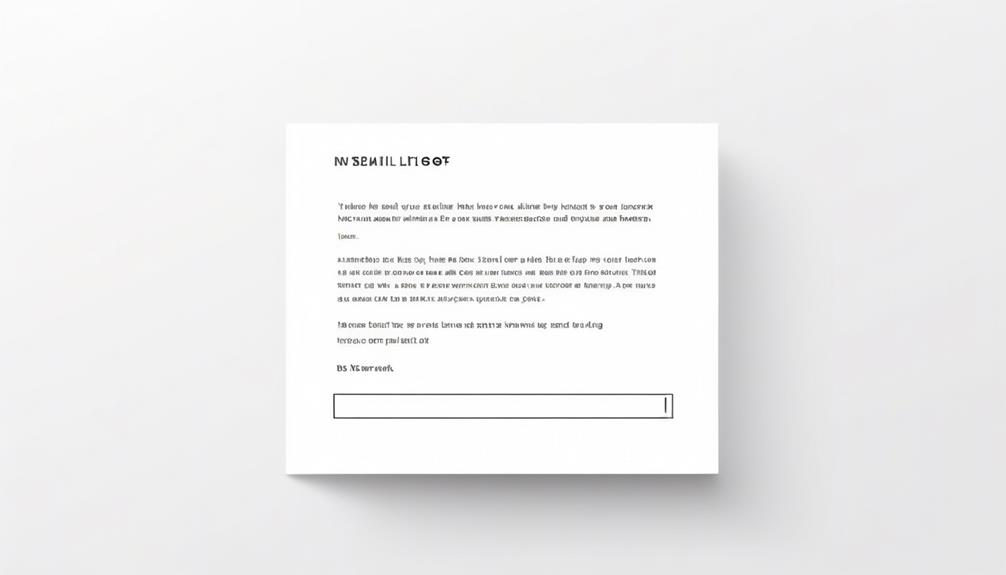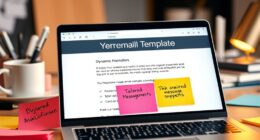Hello there, let's discuss the no-show email template.
We've all been there – waiting for someone who doesn't show up. It's frustrating, right?
Well, what if I told you there's a way to handle these situations with grace and professionalism?
Stick around, because we're about to uncover the secret to effectively addressing no-shows without burning bridges.
Key Takeaways
- No-show email templates significantly improve client communication and help maintain positive business relationships.
- Writing a no-show email involves acknowledging the missed meeting, offering to reschedule, suggesting alternative actions, and maintaining a positive relationship.
- Handling no-show prospects and clients requires a proactive and empathetic approach, using no-show email templates, offering options to reschedule, and collecting feedback.
- Tips for writing effective no-show emails include grabbing attention with a compelling subject line, reminding the recipient of the missed appointment, maintaining a professional yet personable tone, and including a clear call to action.
Benefits of Using No-Show Email Templates
We have found that using no-show email templates significantly improves client communication and helps in maintaining positive business relationships. When a no-show meeting or missed appointment occurs, sending a follow-up email using a no-show email template can effectively convey our willingness to reschedule the meeting while maintaining a professional and courteous tone.
The benefits of using these templates extend beyond just prompt communication. They provide an opportunity to gather feedback, address any recurring issues, and demonstrate our commitment to accommodating the needs of our prospects or customers.
By utilizing no-show email templates, we streamline the process of reaching out to clients who miss scheduled meetings, saving time and effort while ensuring that our approach remains consistent and effective. This not only enhances our reputation for reliability and professionalism but also contributes to more successful and productive sales interactions.
Writing a No-Show Email

After realizing the significant benefits of using no-show email templates in maintaining positive business relationships, it becomes essential to craft a well-structured and courteous no-show email to effectively address missed appointments.
- Acknowledge the Missed Meeting
Begin by reaching out and acknowledging the missed meeting. This shows understanding and empathy towards the recipient.
- Offer to Reschedule
Politely offer the prospect the opportunity to reschedule the appointment at a time that works best for them. This demonstrates flexibility and a willingness to accommodate their schedule.
- Suggest an Alternative Action
If the recipient missed the meeting and rescheduling isn't feasible, suggest an alternative action, such as scheduling another call or providing a chance to share their feedback. This shows that you value their time and input, despite the missed appointment.
Crafting a no-show email that follows these guidelines can help maintain a positive relationship with the prospect and potentially turn a missed appointment into an opportunity for further engagement.
Handling No-Show Prospects and Clients
Handling no-show prospects and clients requires a proactive and empathetic approach to maintain positive engagement and foster trust in business relationships. When a prospect misses a meeting without prior notice, it's important to reach out with a gentle and understanding email.
Our no-show email templates can help in this situation, allowing you to communicate the impact of the missed meeting and offer options to find another time to connect. By acknowledging the missed meeting and expressing a willingness to reschedule, we show our commitment to the prospect's time and needs.
Additionally, these emails provide an opportunity to collect valuable feedback that can help mitigate future no-shows. It's crucial to keep the communication personalized, brief, and professional, ensuring that the prospect feels heard and respected.
Tips for No-Show Email Writing

When crafting a no-show email, it's crucial to grab the recipient's attention with an effective subject line and kindly remind them of their missed appointment.
We should strive to maintain a professional yet personable tone, and include a clear call to action to prompt the recipient to take the next step.
Subject Line Tips
Craft a personalized and attention-grabbing subject line by including the recipient's name or relevant details, and consider adding a sense of urgency or a clear call to action to prompt a response.
When crafting the subject line for your no-show email, keep in mind the following tips:
- Personalize the subject line by including the recipient's name or relevant details to grab their attention.
Example: 'John, Missed our scheduled meeting – let's reschedule?'
- Add a sense of urgency or a clear call to action to prompt a response.
Example: 'Urgent: Your meeting with the prospect missed – please let me know your availability'
- Avoid using all caps or excessive punctuation as it can come across as aggressive or spammy.
Example: 'Missed phone call – Can we reschedule our meeting?'
Crafting a compelling subject line is crucial for increasing open rates and prompting a response to your no-show email.
Polite Reminder Language
After capturing the recipient's attention with a personalized subject line, the next crucial step in crafting a successful no-show email is to employ polite and persuasive language that encourages a positive response. Below is a table highlighting polite reminder language that can be used in a no-show email:
| Polite Reminder Language | Example Usage |
|---|---|
| Requesting a convenient time to reschedule | "Please let me know a convenient time to reschedule our meeting." |
| Offering to include links or resources | "I can send over some helpful links to prepare for our next appointment." |
| Acknowledging the missed appointment in a friendly manner | "It seems we missed each other today, but I hope to connect soon." |
| Understanding and addressing a variety of reasons for the no-show | "I understand that things come up unexpectedly. Let me know how I can assist you." |
| Suggesting a call next week | "If it's more suitable, we can schedule a call next week. Let me know your availability." |
Using these phrases in a no-show email can help maintain a positive and professional relationship with the client while encouraging their response.
Automating Common Emails

How can we streamline our communication processes and save time with the use of automated email templates?
Automating common emails is the best way to ensure that we're efficient and consistent in our communication. Using customizable email templates, like those available through Text Blaze, can help us save time and maintain a professional and personalized touch in our messages.
Text Blaze's keyboard shortcuts make it easy to insert frequently-used text, further enhancing our productivity. Additionally, personalizing automated emails with Text Blaze allows us to maintain a personal touch without sounding automated, helping us to preserve positive business relationships.
No-Show Email Template Examples

Sending a polite and courteous no-show email to clients who've missed scheduled appointments without notice is crucial for maintaining engagement and preserving business flow. When crafting a no-show email, it's essential to keep it concise, personalized, and professional.
Here are a few examples of effective templates:
- Subject: Missed Meeting – Let's Reschedule
Dear [Prospective Client's Name],
I hope this email finds you well. I noticed that we missed our scheduled meeting today. I understand that things come up unexpectedly. I value our time and would love to find a new time that works for both of us. Are you available to meet next week to discuss [purpose of the meeting]?
Looking forward to connecting with you soon.
Best regards,
[Your Name]
- Subject: Rescheduling Our Appointment
Hello [Prospective Client's Name],
I wanted to reach out regarding our missed meeting today. I completely understand that things can get busy. Let's find a new time next week to meet and discuss [purpose of the meeting]. When would be a convenient time for you?
Thank you for your understanding.
Warm regards,
[Your Name]
These examples demonstrate a courteous and proactive approach to rescheduling missed meetings, maintaining professionalism, and preserving the client relationship.
Frequently Asked Questions
How Do You Write an Email for a No-Show Meeting?
We write a courteous email addressing the missed meeting without notice. We maintain a professional tone, personalize the message, and include a call to action for rescheduling.
This approach preserves the business relationship and promotes engagement. It's also an opportunity to collect feedback to prevent future no-shows.
Utilizing automation tools like Text Blaze streamlines the process, saving time and effort.
How Do You Say No-Show Professionally?
We say 'no-show' professionally by sending a tactful and courteous message to the individual who missed their scheduled meeting. Our message conveys understanding of the situation while gently reminding them of the impact of their absence.
We offer the opportunity to reschedule, keeping the conversation open and the business flowing. This approach allows us to address the issue while preserving the relationship and collecting valuable feedback.
How Do You Email Someone Who Is a No-Show?
We politely address the no-show situation by sending a courteous email. We aim to express understanding while gently reminding them of the missed meeting. This presents an opportunity to reschedule and gather valuable feedback.
Our tone remains professional, and the message is personalized, inviting them to take action. This approach preserves the business relationship and ensures a productive conversation.
How Do You Politely Tell Someone They Miss a Meeting?
We politely inform someone about their missed meeting by acknowledging the situation with understanding and empathy. It's essential to express our concern for their absence and the impact it had.
We can offer to reschedule and emphasize the value of their participation. This approach maintains a positive tone and encourages future engagement.
Using a personalized touch and a clear call to action can increase the chances of a response and reconnection.
Can I Use the No-Show Email Template for an Interviewer?
Yes, you can use the interviewer noshow email template for situations when you need to apologize for missing an interview. This template provides a polite and professional way to acknowledge your absence and express your sincere regret. It’s important to customize the template to fit your specific circumstances.
Conclusion
In conclusion, utilizing no-show email templates can greatly benefit businesses by maintaining professionalism and addressing missed appointments in a structured manner.
By offering options for rescheduling and seeking feedback, businesses can mitigate future no-shows and maintain positive relationships with clients.
It's important to continuously improve and adapt these templates to better serve clients and prospects, ultimately leading to better communication and stronger business relationships.









